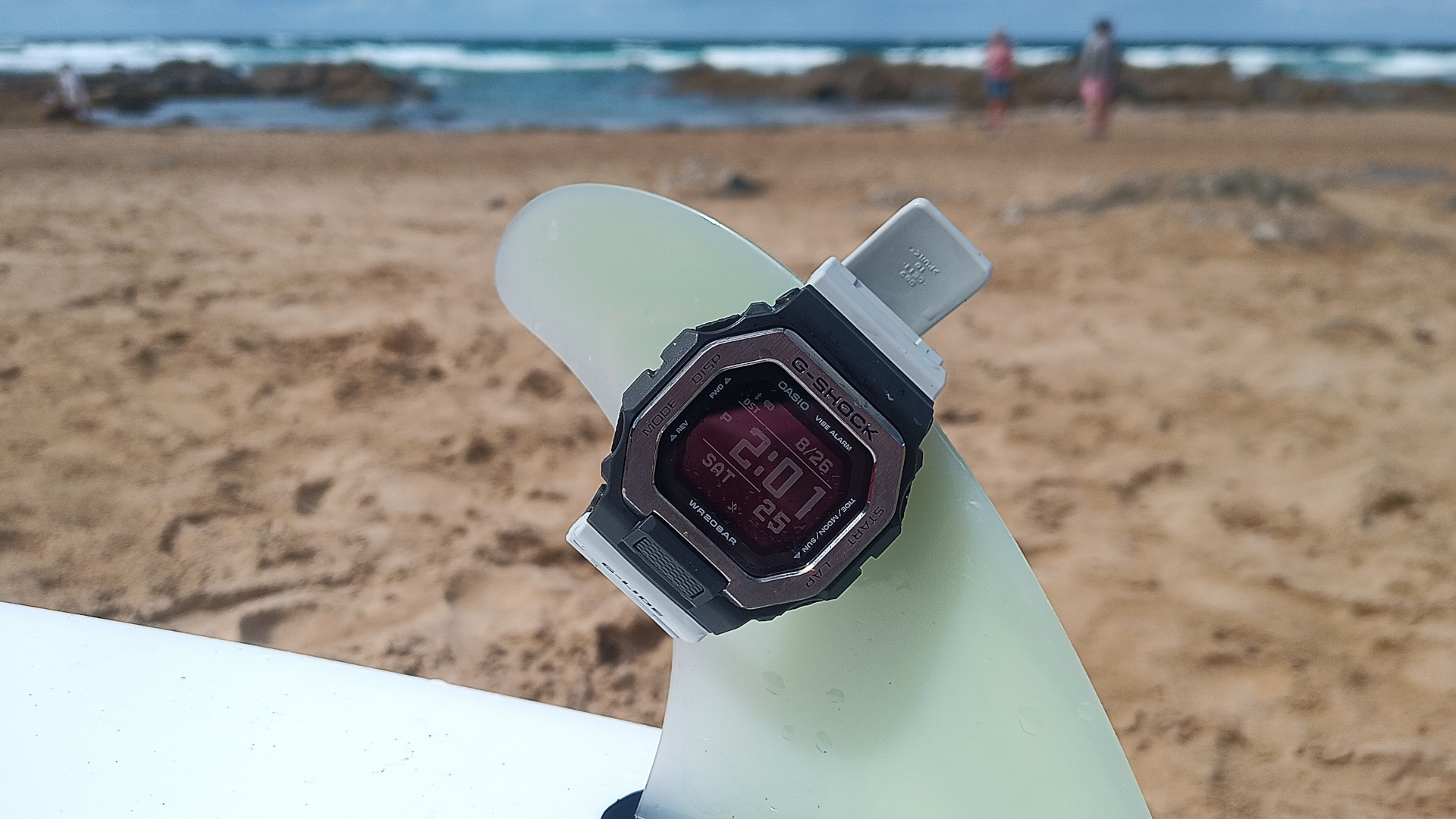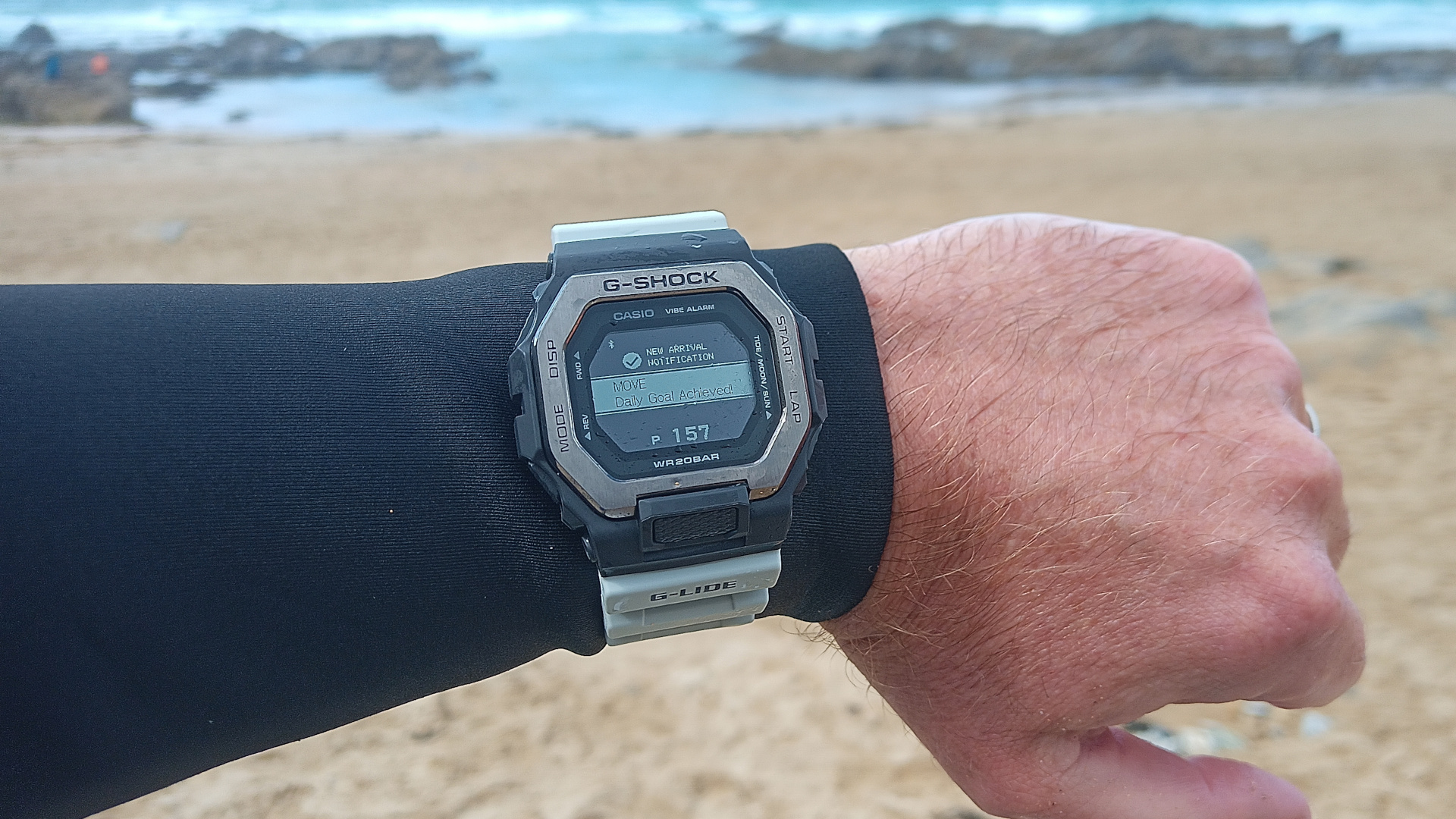I've given up on smart watches for surfing – I'm using this Casio G-Shock surf watch instead
I'm going super simple to keep surf freedom with the Casio G-Shock G-Lide

If you've ever surfed and enjoyed it, then you probably understand how waves are like a time machine. "I'm just going to catch some waves, be back in a few," said every surfer ever – before realizing those "few" weren't minutes but hours. That's the point of the great surf escape. But the idea of having that, while still being able to know the time, sounds ideal. This is where the Casio G-Shock G-Lide GBX-100 comes into its own.
I spent several months with this simple, solid, and strangely satisfying wrist adornment. That included a good few surf sessions as well as day-to-day use. To be clear, I'm used to reviewing complex and smart sports watches like the best Garmin watch options, and even the best Apple Watches like the Apple Watch Ultra 2 feature Surf workout profiles, so you never need to take them off. These smartwatches can not only track your every heartbeat and breath, but watch you while you sleep too. Yeah, sounds creepy when you say it like that.
And taking a break from it was wonderful.

Casio gives you the basics and it does them very well. That means a high-contrast, clear MIP LCD display with the time and date, plus a chunky, easy-to-find, front button that lights it all up at night. From a surf perspective, this is ideal. You have a waterproof buddy that clearly shows you the time you've been out there, and the time of day, at a glance in all conditions – from bright sunlight to a dark storm.
That's where this watch really appealed to me. I could pop out, leaving everyone else on the beach, knowing I could be back at a certain time. Otherwise, I might not go out at all, thinking I'd end up not knowing how long I was in the waves and missing our go time or – even worse – lunch.

But the watch does more than just stop you from missing your next meal. This clever wristwatch features dedicated tide and moon data across over 3,300 locations worldwide. That means you can set the beach you're surfing at and the watch will offer up sunrise and sunset times as well as high and low tides. Plus there's a graph that shows the tide so you can see when it's best to head out.
All that sounds lovely, and is fun to have. Yet, in reality, the cramped display size and lack of internet-connected accuracy will likely mean you use this as a very rough guide at best or not at all, in favor of firing up the Surfline app on your phone instead.
Sign up for breaking news, reviews, opinion, top tech deals, and more.
| Component | Casio G-Shock G-LIDE GBX-100 |
| Price: | $160 / £149 / AU$399 |
| Dimensions: | 50.9 x 46 x 14.7 mm |
| Weight: | 66g |
| Display: | Memory In Pixel (MIPS) LCD |
| Case/bezel: | Plastic / Stainless Steel |
| Battery life: | Around two years |
| Water resistant: | 200 metres water resistant |
The tracking option is similar in terms of use, letting you time your workout or surf. But if you want to include metrics like your speed or distance, you'll need a connected phone with you to have that GPS – which this simple watch doesn't feature. So, in reality, I used this as a watch and that alone.
In contrast, Garmin's surf app shows you how much distance you covered, how many waves you've caught, and even the speed at which you traveled on each wave. The G-LIDE GBX-100 doesn't have any of these features, but that's not a bad thing.

This is a really comfortable and good-looking watch that got a number of comments thanks to its retro style and the attractive brushed stainless steel bezel. The strap is super easy to put on, even over a wetsuit, and holds in place perfectly so when you're surfing you don't even notice it's there.
Crucially though, this has a replaceable battery meaning you never need to charge it. So no lugging about a charger, no worries about this dying when you need it. This watch is solid and reliable, so you can focus on surfing, or whatever else you're doing, with this wrist-buddy accompanying you.

It's worth mentioning that this will connect via Bluetooth, not only to track activities but also to offer you notifications from your phone. In reality, the app has to always be on, taking up a slot at the top of your phone's screen, and it's fairly limited in the notifications you get. Helpfully you can see incoming calls – ideal if your phone is on silent – or messages coming in.
However, to actually read them is a button pressing and menu scrolling faff, not to mention eye-squinting awkward on the super compact screen. But to be notified, so you can check your phone, is helpful. It won't offer all the best smartwatches do, but that's kind of the point.
I just found myself trying not to use the watch with Bluetooth so as to save battery – although a replacement battery is only cheap – but old habits die hard I guess. This should go for two whole years before you need to replace the super cheap CR2032 battery, but not knowing how much impact that Bluetooth connection is having did leave me feeling ill at ease.

So should you invest the £149 in this watch if you're a surfer, or not? The most appealing features for surfers are the time, waterproofing, and comfort. So you could go for a more basic G-Shock watch, save a bit of money and still get the same results. That said it's worth noting that many others don't have that high-visibility MIP LCD display – which was ideal when out on the water.
I want to say you could save a bundle and go for the classic Casio F-91W but since it's only splash-proof I wouldn't recommend that. That said there is a more basic plastic G-Lide at £69 that could serve you well, although the display isn't half as impressive.
All that brings me back to this watch which offers everything you need while out on the waves, in an easy-to-use form with reliable build quality which helps you relax out at sea. I mean I still waited for one more wave after the time I was supposed to go in, of course – but you can't blame the watch for that.
You might also like
Luke is a freelance writer and editor with over two decades of experience covering tech, science and health. Among many others he writes across Future titles covering health tech, software and apps, VPNs, TV, audio, smart home, antivirus, broadband, smartphones, cars and plenty more. He also likes to climb mountains, swim outside and contort his body into silly positions while breathing as calmly as possible.
